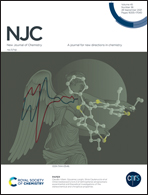An efficient and stable coral-like CoFeS2 for wearable flexible all-solid-state asymmetric supercapacitor applications†
Abstract
Exploring efficient and inexpensive materials for supercapacitors has become a research highlight. In this work, coral-like CoFeS2 nanomaterials were synthesized by an organic solvothermal method and applied to supercapacitors. Due to their large specific surface area and unique coral structure, the CoFeS2 electrode materials exhibited high specific capacity (1457.1 F g−1 at 2 A g−1) and rate performance in a 2M KOH aqueous electrolyte. An asymmetric CoFeS2‖AC supercapacitor delivers a high energy density of 66.4 W h kg−1 at a power density of 790 W kg−1, and the retention rate of specific capacitance is 97.6% after 10 000 cycles at a current density of 10 A g−1, showing good cycling stability. The electrode material of CoFeS2 was assembled into a button battery that can light up an LED or turn on a motor fan. In order to evaluate the feasibility of wearable flexible asymmetric energy storage devices, flexible all-solid-state asymmetric supercapacitors were investigated, which showed a high energy density of 47.2 W h kg−1 at a power density of 525 W kg−1, and the retention rate of specific capacitance was 87.8% after 8000 cycles at a current density of 5 A g−1. This study provides the possibility of applying them in future practical applications, and the synthesis strategy can be extended to synthesize other transition metal sulfide materials with excellent supercapacitor performance.



 Please wait while we load your content...
Please wait while we load your content...